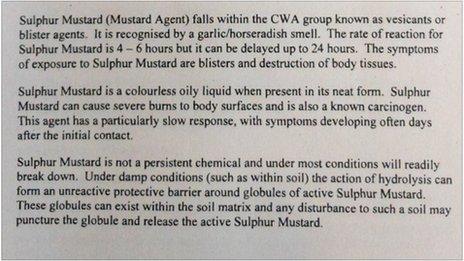Chemical weapon 'risk' at RAF Kinloss in Moray
- Published
Contamination is linked to aircraft dismantling and weapons decommissioning after the end of WWII
RAF Kinloss authorities knew the public could be at risk from chemical weapons buried near the base, according to documents obtained by BBC Scotland.
The Moray base is already the focus of an investigation into radioactive contamination.
A 2004 land quality assessment also warned sulphur mustard chemical weapons may be present within landfill and waste areas accessible to the public.
The MoD has said Kinloss is "suitable for its current use".
The Scottish Environment Protection Agency (Sepa) is investigating radioactive contamination at the site linked to the use of "glow in the dark paint" in WWII aircraft.
This dated to an era when aircraft were broken up and scrapped and it is understood any chemical weapon materials would have been processed around the same time.
'Potential risk'
A land quality assessment completed in 2004 warned a chemical weapons agent may be "present within landfill and waste tip areas located within the alienated land which is accessible to the general public".
The chemical weapons agent was sulphur mustard, which can cause severe burns and is also known to cause cancer.
The risk of contamination was identified in an assessment before construction work began on a new pipeline for a water treatment project.

The report said RAF Kinloss authorities believed there was a potential for chemical weapons agents and radiological contamination to be present in the ground.
It warned: "Any personnel involved in the ground investigation have the potential to be at risk from these contaminants."
No trace of chemical weapons agents was found during the land quality assessment but BBC Scotland has been told material contaminated with radium was removed from land near the base in 2004.
The report's authors also said: "...there are a number of anomalies present on the investigation area the have not been investigated, and in some areas it was not possible to conduct the geophysical survey due to heavy gorse cover".
Site restrictions
A Ministry of Defence spokesman said: "Our investigations to date suggest there is no indication of significant risk to public health or the environment associated with the past storage or disposal of chemical weapon agents in the UK.
"Work undertaken indicates the sites are suitable for their current use, provided that any management systems, restrictions or procedures remain in place.
"We consider protection of human health and the environment to be very important, and if we identify threats to either we inform the regulatory authorities and public as soon as possible ensuring the necessary management measures are put in place."
Moray MP Angus Robertson said: "Recent reports raise questions relating to potential dangers at the Kinloss base.
"Given reports of radioactive material at Dalgety Bay, it is important that we understand the situation at Kinloss.
"This is why I'm requesting a meeting with the defence secretary Philip Hammond.
"It is important that there is as much transparency as possible from the Ministry of Defence."
'Statement needed'
Thomas Docherty, MP for Dunfermline and West Fife, said: "These revelations are deeply worrying."
He added: "We need an urgent statement from the UK government that spells out who knew what when, that says what is the actual scientific risk, when did they inform the Scottish regulators, when did they inform the local authorities, and when did they inform Scottish ministers? That needs to be done as soon as practical."
About 900 Army personnel and their families from 39 Engineer Regiment, based at Waterbeach near Cambridge, are due to arrive at the base this summer.
Kinloss was closed as an air force base as part of the UK government's ongoing programme of defence cuts.
- Published18 May 2012
- Published9 May 2012
- Published2 May 2012